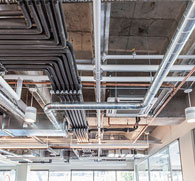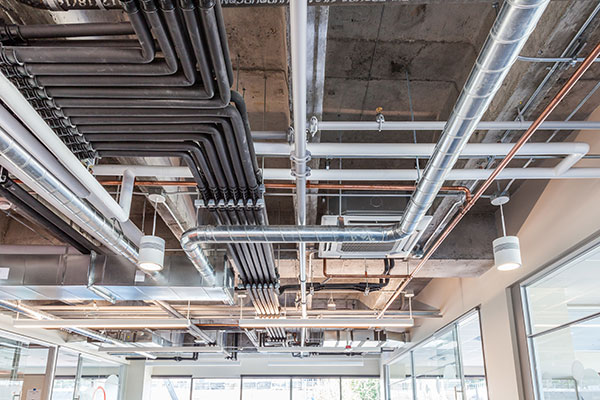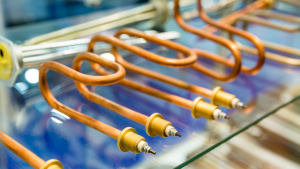The initials HVAC stand for Heating, Ventilation, and Air Conditioning. An HVAC system is comprised of the equipment and technologies used in both commercial and residential buildings to control the heating and cooling of the building. This definition is generally accepted across the industrial sector.
Heating
Heat may be direct or forced air in nature. Direct systems take the heat directly to an area, using hydronic (steam or hot water) or electric radiant floor systems, baseboards or radiators. Forced air systems are the most common type of heating, via a central heating and air system. The air is heated in a furnace and distributed throughout ductwork to registers in a room. Fuel sources for forced air systems consist of natural gas, propane, oil, or electricity. Forced air heating relies on a “return” of cold air to the furnace and many forced air systems have two sets of ducts and outlets: one circulating hot air and one with vents on or near the floor to return the sinking cooler air. Heat may also be generated by a “heat pump” (also called an exchanger), a more efficient generator that uses compression and condensation to draw heat out of air in cool weather. Heat pumps can use air or ground (geothermal) heat but lose efficiency when the temperature outside is a great deal cooler or warmer than the indoor air, making them an efficient supplement for HVAC systems in some areas.
Radiant heat system heats a building through the process of radiation or direct transfer of heat from a hot surface to a cold one. The heat is distributed through hot water tubing implanted in the floor, radiant panels in the ceiling, or from heating stoves. A boiler, fueled by natural gas, propane, oil, or electricity, is used to heat the water, allowing the direct transfer of heat to a space.
A hydronic system is similar to a radiant system. It uses a boiler to heat water through a combination of radiation and convection. The heated water is either piped to “fin-tube” baseboards along the walls or distributed by convection as the air rises, heated by the baseboard unit. Fuel sources for the boiler are the same as radiant heat.
A geothermal system uses a heat pump to take heat from one source and deposit it into another. Beneath the earth’s surface, the temperature is a constant 50 to 60 F, a natural and everlasting source of heat. The geothermal heat pump takes advantage of this constant heat source by transferring and concentrating the heat to provide a source of heat energy for space heating and a heat sink for space cooling.
When your heating system doesn’t work, temperatures can quickly drop lower than is comfortable for workers. A study by Cornell University conducted at the Insurance Office of America’s headquarters found that workers who found their environment cold were more prone to make errors. They concluded that the average monetary penalty associated with these errors was estimated to be a 10% increase in each workers’ hourly labor cost.
Ventilation
Ventilation is key to keeping the temperatures in a building within the range you want and providing healthy air throughout every room. There are five different methods of ventilating a building:
Natural ventilation: Allows natural air movement in and out of an area through cracks or holes. Generally, if you’re using this, you have no HVAC system to speak of.
Exhaust ventilation: Indoor pressure is set to be lower than the pressure outside through a fan or fans connected to an exhaust point located centrally within a building. Exhaust ventilation can be amplified by connecting these fans to ducts going to multiple rooms.
Balanced ventilation: Has a mix of fresh outside air and inside air. Similar to exhaust ventilation, but with the addition of fans and ducts that introduce fresh outside air. Requires filtration to prevent dust and pollens from coming into the building.
Supply ventilation: The opposite of exhaust ventilation—pressurizes a building using a fan system to push outside air into a space and letting air leak out of the area through holes in the fan ducts and intentional vents. Resistant to outdoor pollutants and requires filtration like balanced ventilation.
Energy recovery: Provides controlled ventilation and reduced energy loss by transferring heat outside and supplying cool air into the building.
Study after study has shown that the amount of ventilation, or fresh outdoor air brought inside, is a critical determinant of health. Good ventilation has been shown to reduce sick building syndrome symptoms, cut absenteeism, and even reduce infectious disease transmission.
Air conditioning
Air conditioning systems work in reverse of heating systems. Instead of creating heat, air conditioners use energy to extract heat from homes and buildings. Usually, air conditioning systems use a compressor to transfer heat from indoors to outside. The compressor runs on refrigerant, which changes back and forth between liquid and gas. As the refrigerant changes, it absorbs and releases the heat. Air conditioning systems can be in the form of central AC units, heat pumps, ductless systems, and evaporative coolers.
Working in an environment that is too hot can make workers lethargic and unfocused. Heat stress can cause the body to lose electrolytes and water faster, causing low mental performance and decreased motor skills. Your body will be trying to preserve energy, which will undoubtedly slow your minds, making completing tasks and avoiding errors a difficult feat.
This is particularly problematic in workplaces where people are working in high temperatures with high humidity, poor ventilation and the use of heavy machinery and equipment that creates heat.
It’s easy to see that each facet of your HVAC system is important to the overall wellbeing of both your employees and your business. It’s best to have a reliable HVAC contractor on call to deal with any maintenance issues you need fixed promptly and professionally.
Get in touch with Level One HVAC for design consultation, installation, service, and maintenance for HVAC systems. Call us at (248) 486-6500 and we’d be happy to talk about what we can offer you! If you don’t have time for a call, you can simply fill in our online contact form and someone from our team of customer service specialists will get in touch with you at a time convenient for you.
Don’t be a stranger, stop by and stay in touch on our social media feeds: Facebook Fan Page / Twitter Feed / Google+ Account / LinkedIn Company Page














